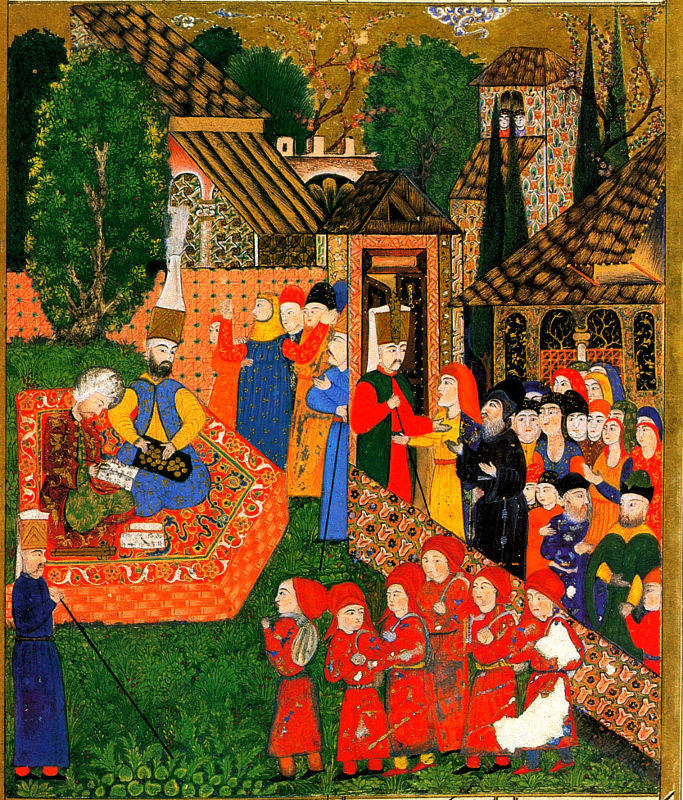Identity in the Empire: Enslavement
Enslavement was institutionalized in the Empire, and took many forms.

Suleymanname (‘Book of Süleyman’, an illustrated history of the life of Süleyman I) of 1588. Boys in red uniforms wait while the Devşirme Emini, the ranking Janissary officer in charge of recruitment, organizes their transport to Constantinople. On the right a Janissary soldier–himself once recruited by the Devşirme–reassures an anxious mother, who is supported by a priest, identified by his black robes. (Ms. Haz. 1517, f.31b, Topkapi Lib., Istanbul).
The practice of taking young Christian boys, ages 8-18, from their families, and raising them to serve in the imperial administration is known as devşirme, which means “lifting” or “collecting” in Ottoman Turkish, and was also known as the ‘blood tax.’ There were two main concentrations of Christian subjects in the Empire, in the Balkans and in Anatolia–Sinan entered imperial service as a result of this ‘tax.’ All such enslaved were required to convert to the Muslim faith. They were trained for military combat, and comprised the majority of the Janisseries, an elite soldier class in the Ottoman army. They were paid for their service, unlike many other enslaved people in the Empire. Devşirme was discontinued in the mid 17th Century.
Domestic enslavement was practiced by the Ottoman landed military aristocracy; men and women (and male and female children) were bought and sold in markets in major towns. The Imperial harem ( defined as ‘sanctuary’) was largely populated by enslaved women, or the daughters of enslaved women, with most originally taken in war . The imperial concubines were capable of gaining great power, and aspired to the position of Valide Sultan, a title granted to the legal mother of ruling Sultan. During the reign of Süleyman I, the Sultan’s favorite concubine was given the title of haseki sultana. Generally subservient to the Valide Sultan, only a few achieved status and power independent from the Valide Sultan. An example is Hürrem Haskei, known in the west as Roxelana–for more information see the text accompanying the bath she commissioned, built by Sinan, the Haseki Hürrem Sultan Hamamı.
In the 19th century most European states instituted abolition, and the pressure exerted on the Ottoman Empire is reflected in the decrease and eventual ban on slavery. Clandestine enslavement continued until the end of the Empire, much reduced.
Further reading:
Troutt Powell, E. (2012) Tell This in My Memory: Stories of Enslavement in Egypt, Sudan and the Late Ottoman Empire (Stanford University Press.
Dr. Powell will be a guest lecturer on Oct 8, speaking on enslavement in the Ottoman Empire in the Great Hall of the Honors, Scholars and Fellows Building at 5:30 pm.